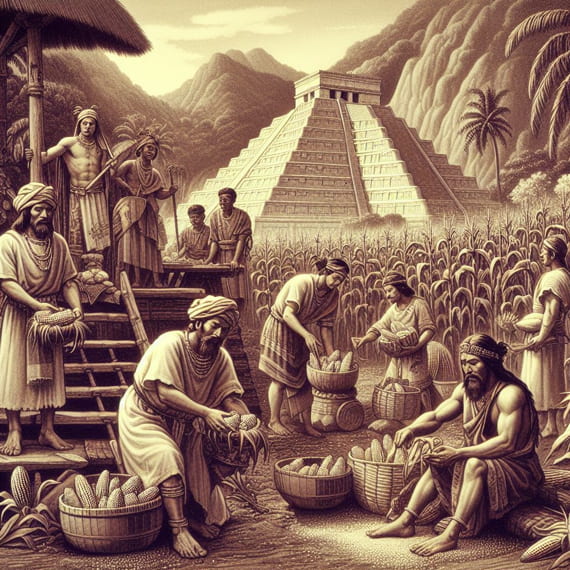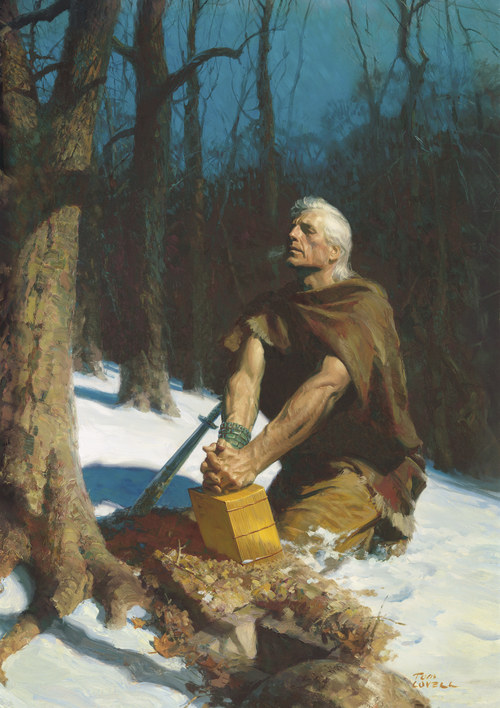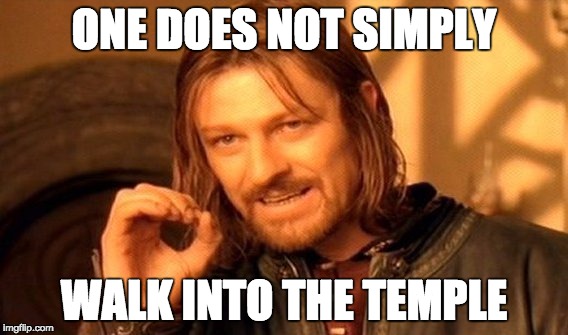Category: Guest Bloggers
-

All Indians Today Descend From Lehi
As the children of Lehi and Sariah intermarried with first Ishamel’s offspring and then their children intermixed with the natives of the Americas, what has been the result genetically after 2,600 years? Are the American Indians encountered by the Europeans in 1492 and beyond also descendants of Lehi and Sariah?
-

Sherem the Native American
Despite keeping the name-title of the Nephite founder in their royal name, the outsized positive influence of that prophet-king and founder of the Nephites was clearly quickly missed. “The people of Nephi, under the reign of the second king, began to grow hard in their hearts, and indulge themselves somewhat in wicked practices,” Jacob lamented…
-

Nephite Succession Crisis
It was a coup (or divine providence) that Nephi and his brothers Jacob and Joseph were able to assert themselves as religious leaders in this new land, spiritually guiding thousands who were already in the Americas. Emerging as the political leaders of this large, mostly non-Jewish People of Nephi was trickier. Nephi’s inspired leadership, however,…
-

Lehi’s Thanksgiving
I envision Lehi and his family encountering some curious native villagers near their initial landing beach in the Promised Land. I can imagine that the first Native Americans to see these strangers from the Middle East sailing to their shores in a vessel larger than any canoe may have viewed them as gods. From Christopher…
-
The Tribes that Greeted the Lehites
As we read the Book of Mormon, we will better appreciate its authenticity if we see its stories in the context of the Nephites and Lamanites continuously bumping up against Native American tribes who were already in the Americas. The Promised Land was not an empty land, as many throughout Church history sometimes imagined. In…
-
2024 Church History Symposium
2024 Church History Symposium “Shall the Youth of Zion Falter?” The Young Women?and Young Men Organizations of The Church of Jesus Christ of Latter-day Saints
-
2024 Call For Library Research Fellows In Mormon Studies, University of Virginia
The University of Virginia’s Mormon Studies Program is pleased to announce the inaugural award of the Aileen H. and Hal M. Clyde Research Fellowship in Mormon Studies and Gender. For the year 2024, as many as two fellowships of $2,500 will be awarded for research in the Gregory A. Prince Collection related to Mormonism and…
-
Redefining Apostasy: Building Bridges, Not Barriers, in the Face of a Faith Transition
The following is a guest post by Randall Davis. Amidst the tapestry of human experience, religious freedom–the right to worship in accordance with one’s own conscience–is a deeply-valued principle that forms the bedrock of much goodness in our world today. Having associated with people of various faith traditions over the years, I have seen the…
-
An MTC Experience
This excerpt comes from Under the Long White Cloud: A Missionary Memoir of New Zealand by Miles Farnsworth. It tells the story of a two-year Latter-day Saint mission, starting with President Thomas S. Monson’s historic policy announcement lowering the age of service for young men and women. The book is more a travelogue and coming-of-age story than…
-

I Even Remain Alone: LDS Men sans Families
I wrote this in over three years ago in response to a call for personal essays on LDS single experiences; alas, it was declined primarily for a lack of anecdotes. It’s not something I would necessarily write today and is longer than a normal blog post. Nevertheless, it’s still a perspective that I rarely see,…
-
Is Activity Increasing Among US-based Latter-day Saints?
The following is a guest post from Stephen Cranny. Stephen Cranney is a Washington DC-based data scientist and Non-Resident Fellow at Baylor’s Institute for the Studies of Religion. He has produced over 20 peer-reviewed articles and five children. I calculated the percent of people who self-identify as Latter-day Saints who are “active” (attend Church about…
-
Welcome to Guest Blogger Michael Haycock
Times & Seasons is pleased to welcome Michael Haycock as our latest guest blogger. Michael was primarily raised in Northwest Ohio and served his mission in Argentina. After graduating with a B.A. in political science from Yale University, he received an M.A. in religion (American religious history) from Claremont Graduate University, where he wrote his…
-
Grace and Cooperative Salvation
Since at least the time of Augustine of Hippo and Pelagius, western Christianity has been embroiled in a debate about salvation and grace. The two extremes have been represented as salvation by grace alone and earning salvation by our own works. Theologians and Church leaders in the Church of Jesus Christ of Latter-day Saints have…
-
“Come, Thou Fount of Every Blessing” Throughout the Restoration
I remember seeing a survey several years ago that claimed that the two most popular hymns among Latter-day Saints were “I Stand All Amazed” and “Come, Thou Fount of Every Blessing”. I have not been able to find that survey online in recent years, but the latter hymn would be an interesting case, since it…
-
A Restored Gospel Christian Calendar
We sometimes speak of the idea of a holy envy—meaning something that we admire in another a religion. For years, while remaining active in my ward, I spent a considerable amount of time at a Presbyterian Church ringing English handbells. Over time, one feature of their worship that I developed a bit of a holy…
-
Times & Seasons Re-Welcomes Bryan Hickman
Times & Seasons hopes you will join us in welcoming our latest guest blogger, Bryan Hickman, for his guest-blogging stint with us (see here for his prior posts). Bryan is a semi-reformed Utah Mormon (whatever that means) doing his best to rein in the knee-jerkedness of his worldview (whatever that means). He went to school…
-

What Can Church Youth Leaders Learn from Baltimore?
For ten years, a Baltimore non-profit called Thread has been working with the youth of that city. Thread’s goal is to “foster students’ academic advancement and personal growth into self-motivated, resilient, and responsible citizens.” It does this by seeking out underperforming high school students and providing each one with a “family of committed volunteers” who…
-
Times & Seasons Welcomes Levi Jones
Times and Seasons hopes you will join us in welcoming our latest guest blogger, Levi Jones. Levi is an attorney with the U.S. Department of Commerce, where he handles general litigation matters. Prior to joining Commerce, Levi worked for several years as a corporate lawyer for a D.C. area firm. Levi earned his law degree…
-
Saints, Volume 1: A Review
About a week ago, the first volume of the new official history of the Church was published. I finished reading through it this weekend, and I have to say that it is fantastic. The style of prose reads like a novel (many creative authors were employed as the writers or consultants for the book), but…
-

The Bread of Life, with Chocolate Chips
Today I am pleased to present a guest post from a good friend of the blog, Samuel Morris Brown. I learned to cook when my wife was recovering from cancer surgery. There’s a hollowness, kindred to cancer, hungry to swallow you up when a beloved’s life is threatened. I still remember, with a soul-deep ache,…
-
Review: William V. Smith’s ‘Textual Studies of the Doctrine & Covenants’
In October 2007, I returned home to Texas from my mission in Nevada. In April of the following year, the raid on the YFZ Ranch near Eldorado, TX, occurred. I didn’t think much about it at the time because, you know, they weren’t real Mormons (as many LDS are wont to say). However, a good…
-
Hurlbut’s Story of the Bibles
Jesse Lyman Hurlbut, a Methodist minister, first published the Hurlbut’s Story of the Bible in 1904. In the book, he retells 168 Bible stories in simplified modern English prose. The author’s purpose was to provide a version of key scripture passages that young readers would find accessible. The numerous republished editions that have appeared throughout…
-
Be Still My Soul
When I was 19 years old and a junior at BYU, I took a volunteer opportunity teaching a semester-long “life skills” class at the Utah State Prison. Maybe it’s not apparent from that one sentence how absurd it was for a sheltered Mormon girl from rural Canada to be teaching “life skills” to a bunch…
-
On Silence: A Midrash of Elijah
Most of us are familiar with the story of the prophet Elijah, who is particularly famous for his dramatic confrontation with the priests of Baal. My favorite part of Elijah’s story comes after that, though, when he realizes that not much changed as a result of his demonstration of God’s power–the people are still worshiping…
-
T&S Welcomes Guest Blogger Michelle Lee
Times and Seasons hopes you will join us in welcoming our latest guest blogger, Michelle Lee. Michelle is a licensed therapist practicing in the San Francisco Bay Area. She currently works full-time for her local school district, providing mental health counseling and crisis management services to adolescents and their families, and also has a private…
-
Three Types of Goodness and Truth
My PhD dissertation was about bias in cost and ridership forecasts for transit projects. Before getting into any data analysis, I address the question of how we should even be evaluating forecasts in the first place. One response to evidence that forecasts for transit projects have generally proven to be overwhelmingly biased has been an…
-

Access to the Temple
During the three years I was a transportation planning student living in Los Angeles (I completed the final two years of my degree remotely), I had fairly consistent access to a car, but I generally only used it as a transportation mode of last resort since I preferred to travel by walking or transit, and…
-
Church and Hockey
I’m Mormon and my husband is not. He has his own religion that constitutes an important part of his identity, vaguely informs his religious beliefs, and minimally informs his religious practice. I would not describe him as religious at all. He would describe me as extremely religious. Sometimes people at church ask me if my…
-
Welcome to Guest Blogger Carole Turley Voulgaris
Times and Seasons is pleased to welcome Carole Turley Voulgaris as our latest guest blogger. Carole recently completed her PhD in transportation planning at UCLA and will be joining the transportation engineering faculty at Cal Poly San Luis Obispo this winter following her upcoming maternity leave. For the time being, she lives in the Seattle area…
-
Guest Post: What Can LGBT Mormons Hope For?
A year and a half ago, I invited John Gustav-Wrathall, president of the support group Affirmation: LGBT Mormons, Families & Friends, to share his thoughts on the Church’s new policy affecting LGBT members and their children (see All Flesh from December 2015). Diverging responses to this post gave rise to the idea of hosting a conversation on the blog about…
